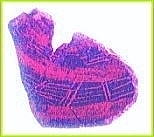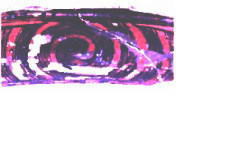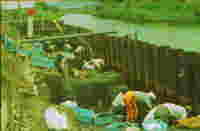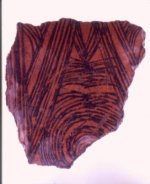


shell mound (Kaizuka) ( It explains in English.)
A number of kaizuka (shell mounds) have been discovered all around japan,
Bones of animals and fishes ,stone tools and pottery shards are excavated from
these shell mounds ,whice help us to reconstrust ancient way of life.
Torihama Shell Mound was formed between 12.000 and 5.500 years ago.
It is a waterlogged site where archaeological remains are found under
thawaterlevel. This particular condition help preserve organic remains,
which usually decompose over time . Thus Torihama Shell Mound is just like
a natural archive where archaeological remains are stored in an exceptional
condition.
Shell mounds are generally thought to be garbage trash of the
ancient people, because many objects used in daily life are found from shell
mounds.
Various plant remains (woods, leaves, seeds, bulbs, nut shells and pollens),
animal remains (mammal bones, fish bones, coprolites, insects) and artificts
(wood crafts, pottery, stone tools, basketry, ropes as well as worked shells,
bones and antlers) were discovered from Torihama
Shell Mound. All these archaeological remains now freshly revive in fromt
of us in their original shapes.
A thread of about 2mm diameter which was made of hemp
Investigation of the digging point 84T by the Takase river in 1984
vessel is covered with lacquered red in a figure painted withblacklines.This kind of vessels was the first appearance。.
A picture in 1980
The middle subject f green isinsect's wings;there is no
method topreserve.
三方の歴史(MIKATA no REKISI) Inquiry into the history of Mikata
鳥浜(TORIHAMA )貝塚(kaizuka)"Inquiry into the history of Mikata-cho includeded Explaination of
theruinsof Torihama shell-mound" is WAKASADAIKKON'S original
information.






